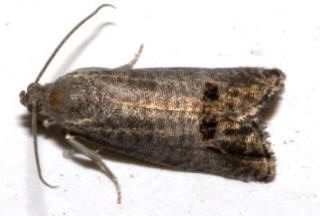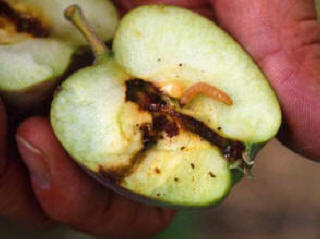The Codling moth and its larvae are severe pests to Apples, Plums and Pears. The larvae burrow into the center of the fruit and eat out channels within the fruit which makes them inedible - or for commercial growers - unsalable. They drop from the maturing fruit late summer, leaving deposits in their tunnels that they have bored and fed from in the fruit.
The Codling Moth is a small moth for the amount of damage it can do, being 1 – 2 cm long at most. It has grey wings with mottling, the length of their small bodies and almost wrapped around as a cover or shroud. A good camouflage as it blends in with tree bark admirably.
It is the larvae or grub that does the damage, and it is important to understand their relatively simple lifestyle or life cycle in order to combat this troublesome pest of fruit – and nut trees.
 The Codling Moth Adult
The Codling Moth Adult
Killing Codling Moth - or even any degree of control is dependent upon timing. There is nothing to be gained by routinely spraying fruit trees. You have to understand, and be guided by their life cycle. If you want to be the local 'anorak' at dinner parties, it is an interesting subject - for some.
 Typical
Damage to Apple fruit by the Codling Moth Grub - Caterpillar.
Typical
Damage to Apple fruit by the Codling Moth Grub - Caterpillar.
One of the most important and effective means of control is simply that of cleanliness around the base of the tree. Together with this, remove infected fruits as soon as they are seen and destroy before the emergence of the larva.
It is often written and thought that grease bands applied to the trunk of fruit trees will help to trap or deter the codling moth. Absolute nonsense! No protection from the Codling Moth with grease bands - Codling Moths can fly! Grease bands are essentially to stop that stage in the life cycle where the developed larva crawl back into the tree after dropping out of the damaged fruit.
Spray with a suitable insecticide – such as Provado Fruit and Vegetable Spray - two or three times from early June - AFTER the flowers have set, or use a Pheromone insect trap. The trap attracts the males into thinking it is the scent of the female! This will give you an idea of the numbers and timing of the codling Moths in your orchard etc, and you can adjust your spraying programme accordingly.
Another option – if the Codling Moth is rife in your area -is to choose early-developing apples and pears which will show some resistance, as the moths will fly around until they find trees that suite their purpose and lifestyle better!
In winter the moth survives in its larvae form, but warmly wrapped in a dense silky cocoon – almost a protection of horticultural fleece! The cocoon lives in bark crevices and fallen litter/debris at the base of the tree. They are happy in this stage until the warming of late march – early April, when they start their next stage of development – turning into full functional moths. They are not active in the day – until late afternoon or early evening, which is their work/pleasure time. They mate in warm evenings. Eggs are then deposited in a convenient place – a leaf, small twig or spur, or anywhere else suitable for the emergent young caterpillars to seek out a developing fruit bud and so be able to bore into the softer tissue.
They continue their development, then conveniently drop out of the fruit – leaving their damage tunnels behind them – and find a snug place in the tree litter to start their pupation stage, or sometimes crawl back up the tree to find a suitable crevice or convenient protective twig joint in which to overwinter. The cycle starts again the following spring.
Main Page for Apple Tree Problems